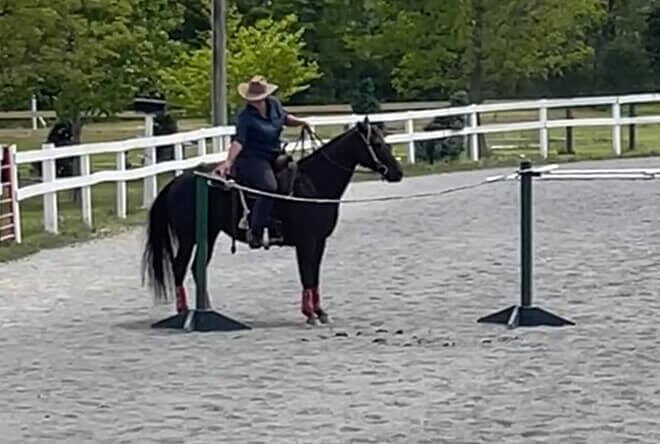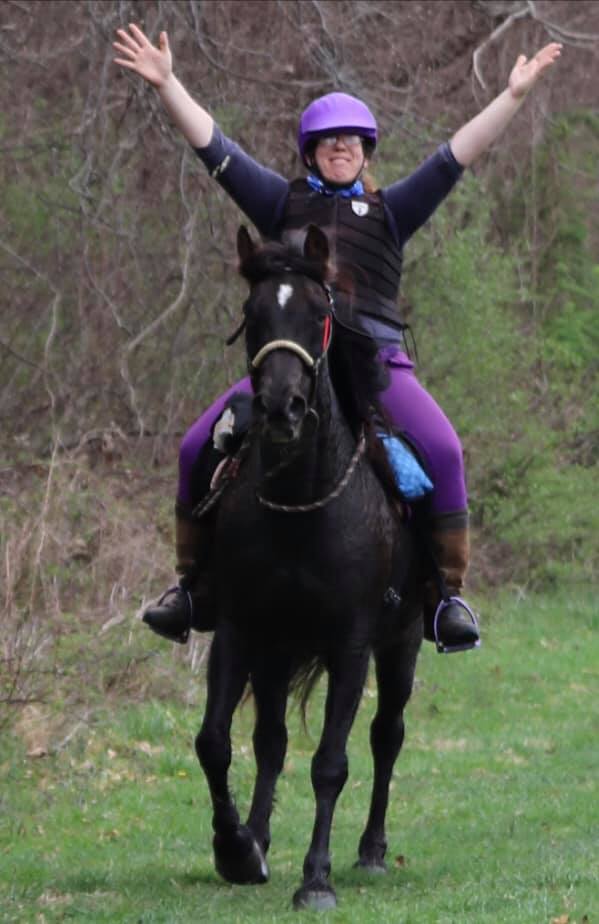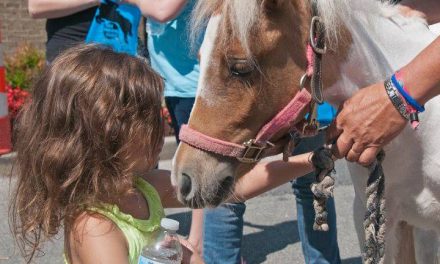first published in the July 2021 Equiery
By Katherine O. Rizzo
Maryland is home to over 1,500 miles of equestrian-use trails, affording everything from ocean views to mountain passes. While hacking down wooded paths is often enjoyment enough, sometimes you may want to show off your off-the-beaten path talents in some friendly trail related competitions. From Endurance to Trail Obstacle Courses to Judged Pleasure Rides and everything in between, we polled Equiery readers and Facebook followers to find out their favorite ways to compete on the trails.
Please note, this may not be a complete list, so if your favorite trails sport is not listed here, let us know by emailing editor@equiery.com. And if you host trail competitions, be sure to send us your show dates by emailing Emily.nessel@equiery.com.

Angela and Skip Kemerer at this year’s Foxcatcher Endurance ride held at Fair Hill in April. (photo by Hoof Print Images)
Endurance
The American Endurance Ride Conference’s motto is “to finish is to win,” which is certainly the case for those who tackle long-distance Endurance rides. Official AERC rides range from 25 to 100 miles in one day and Endurance is a FEI-sanctioned sport.
The basic goal of Endurance is to cross the finish first, however the horses’ welfare is carefully monitored throughout the ride with several veterinary checks along the course. In addition to awards based on rider age, level, and experience, the Best Conditioned award is given to the fittest horse to finish. There are also mile awards that riders can work on over time.
Here in Maryland, the Foxcatcher Endurance ride is held each spring at the Fair Hill Natural Resources Management Area and it seems many Equiery readers attended this year with several sending photos from the ride! Overall, Endurance was the fourth most popular sport in our Equiery poll.
Trail Obstacle Course
Although not technically held on the trails, Trail Obstacle Courses or Trail Classes are a great way to show off your trail riding skills while staying in an arena or enclosed field. Most competitions offer courses with around 10 obstacles such as opening and closing a gate and walking across a bridge.
Each obstacle is timed while competitors are judged on how quickly they navigate the whole course. Some of these competitions are even held in hand with the rider working their horse in hand through the obstacles. These in hand and mounted competitions are often held in conjunction with Western shows here in Maryland but competitors do not have to compete in Western tack if it’s an open competition.
Judged Trail Ride
Judged Trail Rides, also called Judged Pleasure Rides, are trail competitions similar to an obstacle course but the obstacles are out on the trail itself. Competitors follow a marked trail where they encounter 10 to 20 obstacles, typically natural objects such as logs and stream crossings. Sometimes, man-made obstacles are made to simulate a challenge one may come across on a trail.
Judges are stationed at each obstacle to give a score to each rider based on how well they navigate the obstacle, thus making these rides are more performance based. The rides can take up to three hours to complete. They were the third most popular trail sport in our Equiery poll!
Competitive Trail Riding
Competitive Trail Riding both measures the fitness of the horse and judges the rider on horsemanship, thus creating a cross between a Judged Pleasure Ride and Endurance. In these rides, time is important; riders are penalized for going too slow or too fast.
As in Endurance, horses are monitored at several veterinary checkpoints while on course. Distances for these rides are typically 20 to 120 miles and can span up to three days for just one competition.
The North American Trail Ride Conference offers rides in the US, Canada and Mexico. Their mission is to “promote horsemanship and horse care as they apply to the sport of distance riding by offering a variety of challenging and educational experiences designed to strengthen horse and rider partnerships.”
Competitive Trail Riding rounded out the top five most popular trail sports here in Maryland according to The Equiery’s poll.
Extreme Cowboy Race
Take the concept of a Judged Trail Ride and turn it into a speed event and you have the Extreme Cowboy Race. Competitors are judged not only on how well they navigate each obstacle, but how quickly they complete the whole course. Competitors are typically divided into Pro, Non-Pro and Youth divisions.
This sport was made popular by legendary trainer Craig Cameron, whose official Craig Cameron Extreme Cowboy Race made its first, and only, Maryland appearance in 2009 when Loch Moy Farm in Adamstown hosted the event.
Those here in Maryland who love this sport wrote in that they’d like to see these sorts of races return to Maryland, so … who wants to step up and organize one?
Paper Chase
Paper Chases, also called Ribbon Chases, can take on many forms, themes and distances. From Easter Egg hunts to Halloween Trick-or-Treating, these chases are fun for individuals or groups. Typically, various colored ribbons tied to tree branches, fence posts, etc mark the course with the object being to count the most number of ribbons, eggs, treats… whatever is marking the course, within the time limit. In addition, some Paper Chases will also have a secret optimum time to complete the course.
Paper Chases are very popular here in Maryland and are ranked second in our poll of trail sports.
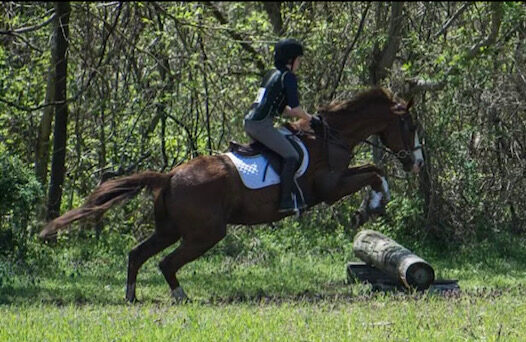
Lucia Simoncelli-DiBenedetto rode in her first Hunter Pace this past April at Marlborough Hunt Club where her team won the Junior Optimum Flat division.
Hunter Pace
Similar to a Paper Chase, riders at Hunter Paces follow a marked course, however, there is no counting involved. The goal is to finish the course closest to the secret optimum time.
Based on the sport of foxhunting, Hunter Pace speeds are similar to a “hunt pace,” meaning the pace you would typically maintain while foxhunting. Thus, many Hunter Pace competitions will offer several courses at one event, to accommodate those who may want to travel a little slower and those keen to race around over large jumps.
The Maryland Hunter Pace Circuit offers both a spring and fall series that is open to all riders, not just foxhunters! This series, along with others offered by groups like the Waredaca Pony Club, are very popular here in Maryland making Hunter Paces the top pick in our poll of trail sports.
Ride & Tie
For a Ride & Tie event, each team consists of two runners and one horse. Rides can be set at distances of 20 to 100 miles with one person starting the race on horseback while the other is on foot. The Ride & Tie Association organizes these races throughout the country as well as holding educational events. Here in Maryland, Foxcatcher held a Ride & Tie during its annual Endurance ride in April.
In this sport, the rider on horseback naturally travels faster than the teammate on foot. After a previously arranged time or distance has passed, that rider will get off the horse, tie it to a tree (or hitching post) and continue on foot, running. The teammate, who started out running on foot, will catch up to where the horse is tied, untie it, get on, and continue down the marked trail on horseback.
When the team member now on the horse, catches up with the runner, the rider can either get off and hand the horse to the runner or continue on riding to the next tie area. This team sport really challenges the people to take advantage of each member’s strengths and weaknesses as they “leap frog” back and forth between running and riding.
Horses are presented for a veterinary check at the start of the race, and at least once during the race. Within one hour of finishing, horses must be re-presented to the veterinary team for one final check before the team’s time can be made official.
Equathon
Similar to a Ride & Tie, Equathon involves two people and one horse. In this case, the rider never gets off the horse and the person on the ground is the only runner. In Equathon, the rider completes the first loop on horseback. Then, when the horse’s pulse reaches the pre-set criteria at the mandatory veterinary check, typically 64-68 beats per minute, the person on foot runs the second lap.
The distance for the rider and the runner may be the same or different, depending on the course. Most courses will be different, with the rider traveling 10-15 miles on horseback and the runner going 5-15 miles on foot.
Competitors can even compete solo as an “Iron Team” where the sole human rides the first loop on horseback, jumps off, allows the horse to reach the pulse criteria, and then runs the second loop on foot.

Katharina Birkmann, Lilliana Sonpar, Brielle Francia and Vivian Rubino practicing at Double C Farm for Mounted Trail Challenges
Mountain Trail Challenge
Mountain Trail Challenges are a more extreme version of a Trails Obstacle Course and is recognized internationally through the International Mountain Trail Challenge Association. The sport is open to all skill levels and competitors can compete English or Western.
Similar to a Trail Obstacle Course, competitors must navigate a series of obstacles, however these obstacles tend to be more rugged than a traditional course. Examples are crossing a wooden bridge that sways side-to-side, riding up steps that get narrower as you ascend and crossing very deep water. Competitors are judged on how well they navigate each obstacle, not on how fast they complete the obstacle.
Those here in Maryland wanting to give Mountain Trail Challenges a try can practice their skills and compete at Double C Farm, featured on The Equiery’s March 2021 cover!
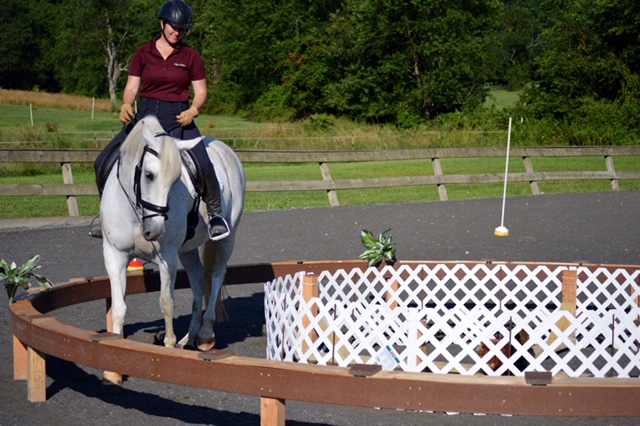
Working Equitation competitions combine trail skills with dressage and ranch work! (Holly Linz photo)
Working Equitation
Working Equitation may be one of the fastest growing sports here in Maryland with more and more riders jumping onboard to this sport that combines various styles of riding into one competition. Working Equitation consists of up to four phases: Dressage, Ease of Handling Trail, Speed, and Cow. However, the Cow phase is only used in team competitions as it requires a team of four riders to separate a specific numbered cow from a group of cows and the Speed phase is only held at the Novice level and above.
The Dressage phase consists of a prescribed pattern of movements, which varies based on the level of competition. The judge(s) score each movement on a scale of 0-10 as well as providing collective marks as they would in classical dressage competitions. Competitors are not restricted to traditional dressage tack however!
The Ease of Handling Trail phase is similar to Trail Obstacle classes with riders navigating obstacles such as bridges and gates. The course is designed to showcase the partnership between the horse and rider and judge(s) score the performance of the horse and rider at each obstacle. The number of obstacles varies based on level of competition.
Finally, the Speed phase uses similar obstacles but riders must complete the course against the time. This phase tests the horse’s and rider’s ability to navigate the obstacles with accuracy as quickly as possible.
Working Equitation became a competitive sport in 1996 with the first European Championships being held in Italy that same year. Here in the US, USA Working Equitation governs the sport. Maryland is part of Region 6 with Oak Spring Equitation holding competitions and schooling opportunities throughout the year.

Teams navigating through the woods with a map and compass during a Competitive Mounted Orienteering competition.
Competitive Mounted Orienteering
Yes, Competitive Mounted Orienteering is a sport and is governed by the National Association of Competitive Mounted Orienteering here in the US. Competitive Mounted Orienteering is a timed event that covers courses of 10 to 20 miles with the objective of finding five to 10 markers using a provided map and a compass. That’s it. No GPS devices. No cell phones. No walkie-talkies. Just you, your horse, a map and a compass.
Each marker is a 9’’ white paper plate with numbers and letters on it. Riders write these letters and numbers down after they find the marker to prove that they were at that location during the ride. Competitors may participate in a pre-ride clinic and practice session before each ride where they are taught how to find a marker on foot before the ride begins.
Riders can compete as individuals or in teams and may travel at any pace they wish. Markers can be found in any order they choose as well. However, the most successful riders tend to keep a good even pace throughout the ride and plan out their course ahead of time. A rider’s time starts as soon as they are handed the map and rider start times are staggered every 10 minutes.
NACMO states, “Competitive Mounted Orienteering is fun and easy to learn, develops trail smarts in both horse and rider, and brings horse people of all disciplines together.”

